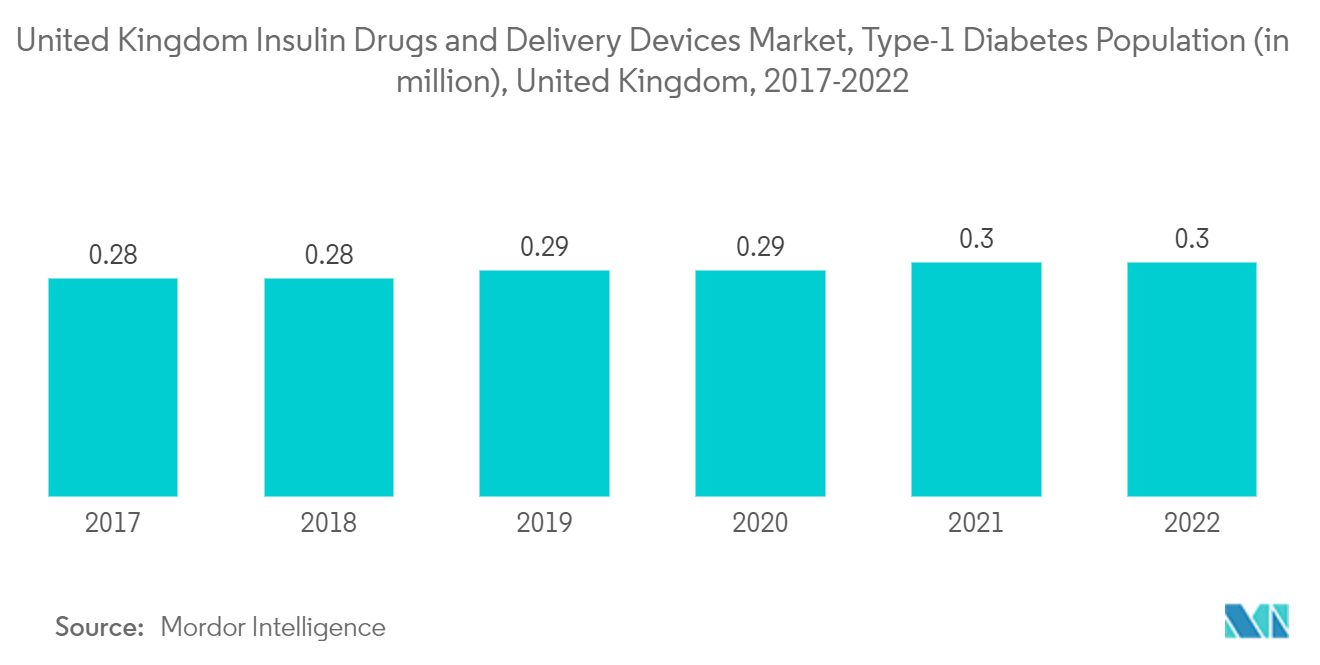Market Trends of UK Insulin Drugs And Delivery Devices Industry
Rising diabetes prevalence
In the United Kingdom, the diabetic population is expected to witness a CAGR greater than 2% over the forecast period.
According to Diabetes UK, more than five million people in the United Kingdom are living with diabetes, which is an all-time high. Their data shows that more than 4.3 million people in the United Kingdom live with diabetes. Additionally, 850,000 people could be living with diabetes who are yet to be diagnosed. These registration figures for 2021-22 are up by 148,591 from 2020-2021. At this rate, the number of people with diabetes, including the undiagnosed population, is expected to rise to 6 million by 2030.
The rate of newly diagnosed Type 1 and Type 2 diabetes cases is increasing, mainly due to obesity, unhealthy diet, and physical inactivity. The rapidly increasing incidence and prevalence of diabetic patients and healthcare expenditure are indications of market growth. Leading manufacturers are focusing on technological innovations and developing advanced products to gain a substantial market share. There has been a significant rise in insulin delivery systems technology, ranging from insulin injections to insulin pumps. Technological innovations and advancements offer many conveniences in maintaining blood glucose levels.
Therefore, owing to the increasing diabetes prevalence, the studied market is anticipated to witness growth over the analysis period.

The Insulin Pumps Segment is Expected to Witness Highest Growth Rate Over the Forecast Period
An insulin pump is a device that automatically delivers insulin continuously, or whenever required. The pump mimics the human pancreas. The insulin infusion pump works as an alternative to the traditional system of daily injections or an insulin pen.
Insulin pumps held a major market share in the insulin delivery devices market in the current year, and it is expected to register a CAGR of more than 4.2% in the market during the forecast period because of the increasing technological advancement and its preference over other traditional methods due to continuous insulin administration. Insulin pump therapy is a well-established insulin administration method for type 1 diabetes (T1DM) people. Pumps are a validated, time-tested therapeutic option in T1DM at all ages, enabling near-physiological insulin delivery in situations where the pancreas does not produce insulin. There are even pump models with remote controls enabling parents of young children to either suspend or bolus insulin from a distance when the child is playing or eating. The insulin infusion pumps reduce the large swings in blood glucose levels, induce less pain, and deliver more accurately when compared to injections. These advantages of insulin pumps over the traditional delivery system are expected to boost the market.
The National Service Framework (NSF) program is improving services by setting national standards to drive up service quality and tackle variations in care. The Association of British HealthTech Industries (ABHI) launched a diabetes section, enabling diabetes technology companies to work together in the first forum of its kind. The ABHI group is for any health technology company with an interest in diabetes care, from CGM and insulin pumps to apps.
The use of continuous subcutaneous insulin infusion (CSII or insulin pumps) and continuous glucose monitoring systems (CGMs) has improved the care and quality of life for patients and is widely used in the ambulatory setting. Increasingly, this technology is also being used in the hospital setting. The COVID-19 pandemic emphasizes the need for good glycemic control in patients with diabetes, largely because most observational studies have reported that poorly controlled diabetes is associated with a higher risk for hospitalization and death from a viral illness. The frequency of monitoring glucose levels depends on the type of diabetes, which varies from patient to patient. Type-1 diabetic patients need to check their blood glucose levels at regular intervals, monitor their blood glucose levels, and adjust the insulin dosing accordingly, which is expected to drive the segment growth during the forecast period.


